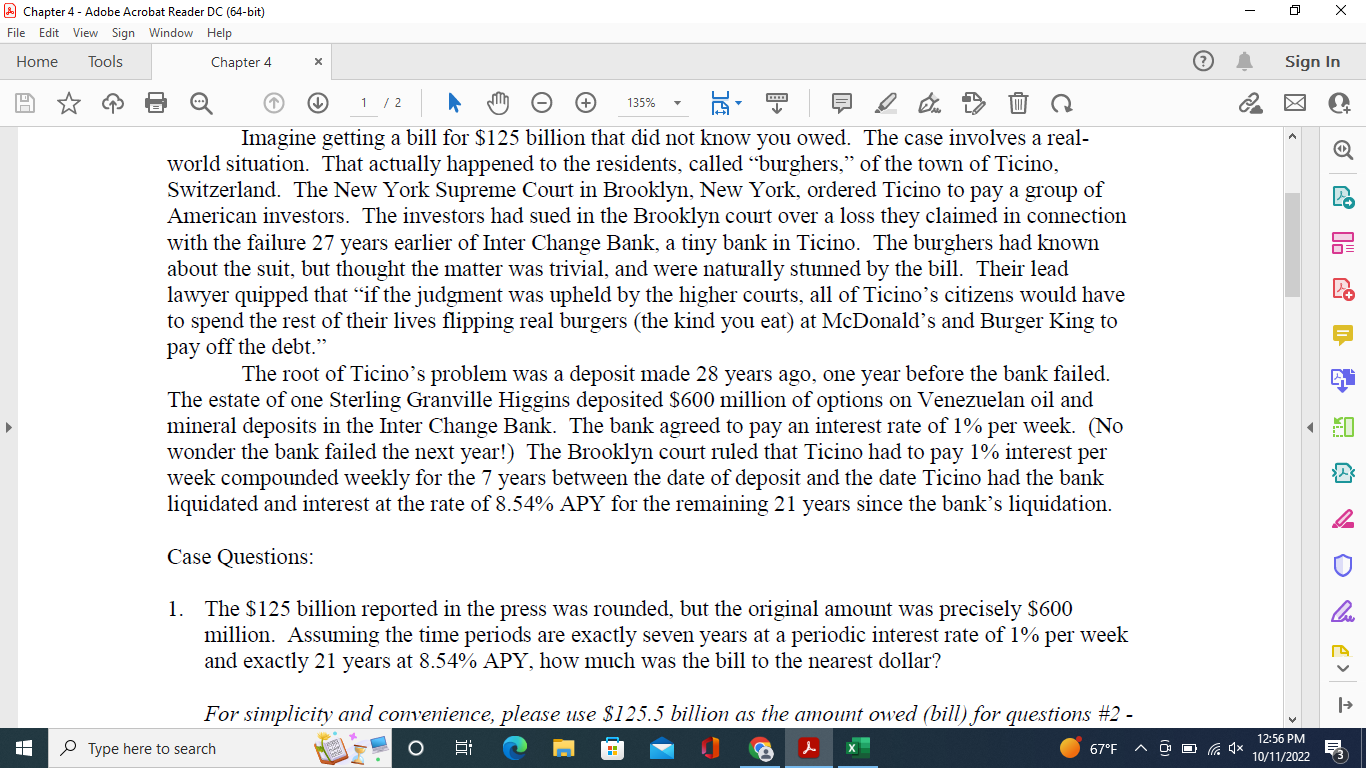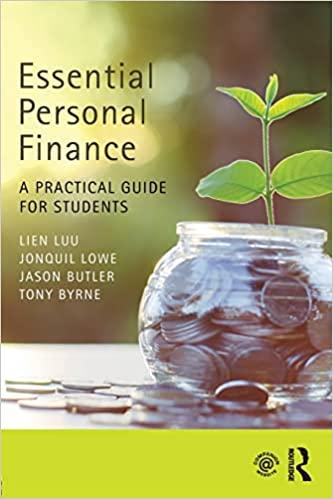
 Can anyone please help me put this in Excel
Can anyone please help me put this in Excel
Imagine getting a bill for $125 billion that did not know you owed. The case involves a realworld situation. That actually happened to the residents, called "burghers," of the town of Ticino, Switzerland. The New York Supreme Court in Brooklyn, New York, ordered Ticino to pay a group of American investors. The investors had sued in the Brooklyn court over a loss they claimed in connection with the failure 27 years earlier of Inter Change Bank, a tiny bank in Ticino. The burghers had known about the suit, but thought the matter was trivial, and were naturally stunned by the bill. Their lead lawyer quipped that "if the judgment was upheld by the higher courts, all of Ticino's citizens would have to spend the rest of their lives flipping real burgers (the kind you eat) at McDonald's and Burger King to pay off the debt." The root of Ticino's problem was a deposit made 28 years ago, one year before the bank failed. The estate of one Sterling Granville Higgins deposited $600 million of options on Venezuelan oil and mineral deposits in the Inter Change Bank. The bank agreed to pay an interest rate of 1% per week. (No wonder the bank failed the next year!) The Brooklyn court ruled that Ticino had to pay 1% interest per week compounded weekly for the 7 years between the date of deposit and the date Ticino had the bank liquidated and interest at the rate of 8.54% APY for the remaining 21 years since the bank's liquidation. Case Questions: 1. The $125 billion reported in the press was rounded, but the original amount was precisely $600 million. Assuming the time periods are exactly seven years at a periodic interest rate of 1% per week and exactly 21 years at 8.54% APY, how much was the bill to the nearest dollar? For simplicity and convenience, please use $125.5 billion as the amount owed (bill) for questions #2 - and exactly 21 years at 8.54% APY, how much was the bill to the nearest dollar? For simplicity and convenience, please use $125.5 billion as the amount owed (bill) for questions #2 #6 below: 2. What is the APY over the entire 28 years as the $600 million grows to the amount owed? 3. Suppose Ticino could pay $5 billion per year. How long would it take to pay off the amount owed assuming interest continued to be charged at 8.54% APY? Assume annual payments begin one year from the date the amount is owed. 4. Suppose Ticino could pay $12 billion per year. How long would it take to pay off the amount owed assuming interest continued to be charged at 8.54% APY? Assume annual payments begin one year from the date the amount is owed. 5. Suppose Ticino decides to pay the amount owed by making 30 annual payments at 8.54% APY. What is the amount of the annual payment if the first payment begins immediately from the date the amount is owed? 6. Suppose Ticino decides to pay the amount owed by making 30 annual payments at 8.54% APY. What is the amount of the annual payment if the first payment begins three months after the date the amount is owed? Imagine getting a bill for $125 billion that did not know you owed. The case involves a realworld situation. That actually happened to the residents, called "burghers," of the town of Ticino, Switzerland. The New York Supreme Court in Brooklyn, New York, ordered Ticino to pay a group of American investors. The investors had sued in the Brooklyn court over a loss they claimed in connection with the failure 27 years earlier of Inter Change Bank, a tiny bank in Ticino. The burghers had known about the suit, but thought the matter was trivial, and were naturally stunned by the bill. Their lead lawyer quipped that "if the judgment was upheld by the higher courts, all of Ticino's citizens would have to spend the rest of their lives flipping real burgers (the kind you eat) at McDonald's and Burger King to pay off the debt." The root of Ticino's problem was a deposit made 28 years ago, one year before the bank failed. The estate of one Sterling Granville Higgins deposited $600 million of options on Venezuelan oil and mineral deposits in the Inter Change Bank. The bank agreed to pay an interest rate of 1% per week. (No wonder the bank failed the next year!) The Brooklyn court ruled that Ticino had to pay 1% interest per week compounded weekly for the 7 years between the date of deposit and the date Ticino had the bank liquidated and interest at the rate of 8.54% APY for the remaining 21 years since the bank's liquidation. Case Questions: 1. The $125 billion reported in the press was rounded, but the original amount was precisely $600 million. Assuming the time periods are exactly seven years at a periodic interest rate of 1% per week and exactly 21 years at 8.54% APY, how much was the bill to the nearest dollar? For simplicity and convenience, please use $125.5 billion as the amount owed (bill) for questions #2 - and exactly 21 years at 8.54% APY, how much was the bill to the nearest dollar? For simplicity and convenience, please use $125.5 billion as the amount owed (bill) for questions #2 #6 below: 2. What is the APY over the entire 28 years as the $600 million grows to the amount owed? 3. Suppose Ticino could pay $5 billion per year. How long would it take to pay off the amount owed assuming interest continued to be charged at 8.54% APY? Assume annual payments begin one year from the date the amount is owed. 4. Suppose Ticino could pay $12 billion per year. How long would it take to pay off the amount owed assuming interest continued to be charged at 8.54% APY? Assume annual payments begin one year from the date the amount is owed. 5. Suppose Ticino decides to pay the amount owed by making 30 annual payments at 8.54% APY. What is the amount of the annual payment if the first payment begins immediately from the date the amount is owed? 6. Suppose Ticino decides to pay the amount owed by making 30 annual payments at 8.54% APY. What is the amount of the annual payment if the first payment begins three months after the date the amount is owed

 Can anyone please help me put this in Excel
Can anyone please help me put this in Excel





